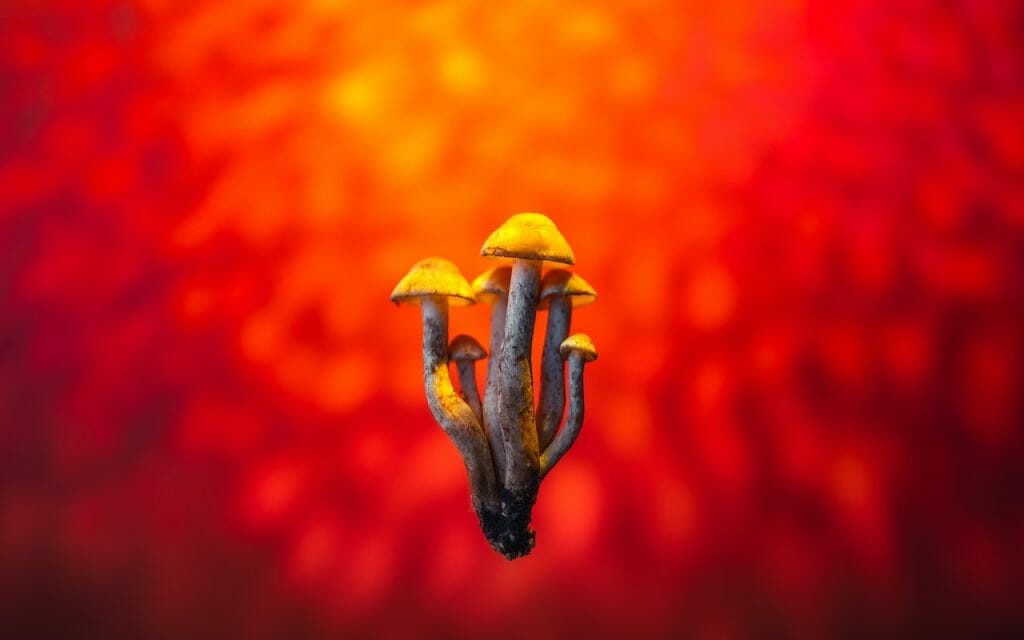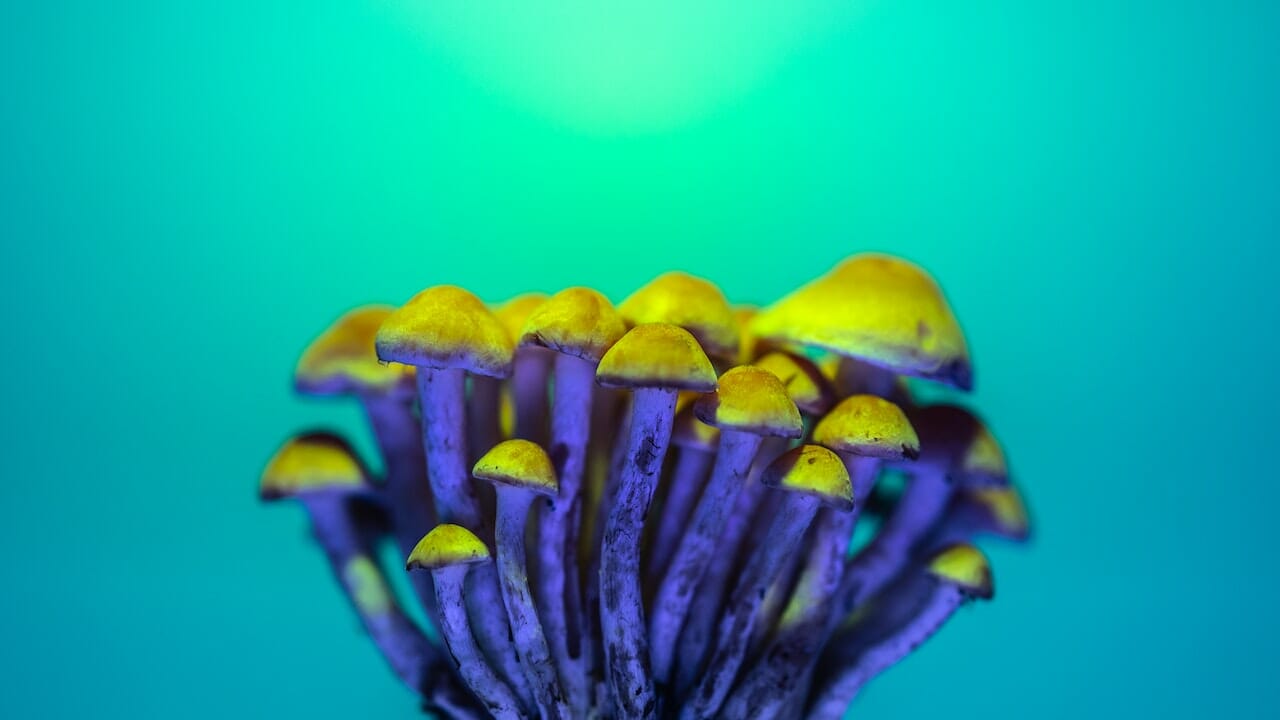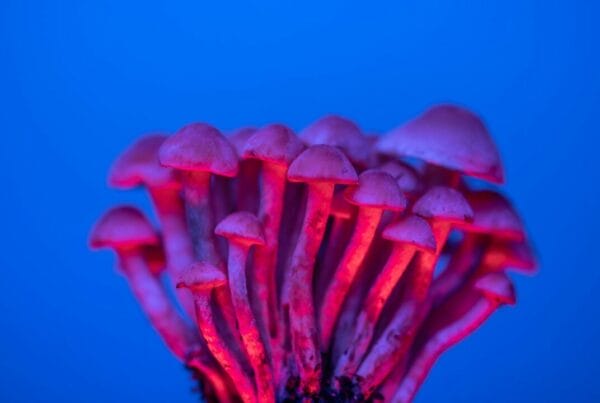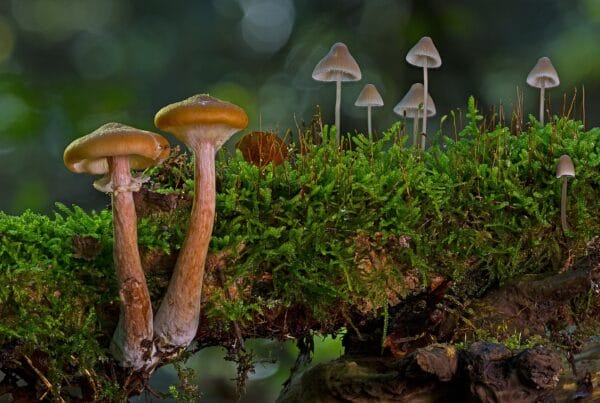Lysergic acid diethylamide (LSD) is an extremely potent hallucinogen that has been the focus of numerous psychedelic research studies. Initially known primarily for recreational use, LSD has evolved into a psychoactive substance that could offer mental health benefits. This change in understanding has broadened the scope of research into LSD’s effects, particularly in more accessible forms such as LSD edibles.
Key Takeaways:
- LSD, a powerful hallucinogen, originates from the ergot fungus.
- LSD shares similarities with psilocybin and interacts with the 5-HT2A receptors.
- LSD can produce effects such as altered vision, mood changes, sense of self-dissolution, and quasi-hallucinations.

Demystifying LSD
LSD is an exceptionally powerful hallucinogen capable of profoundly altering one’s perception of reality and drastically distorting sensory input. LSD is derived from “ergot,” a fungus that grows on rye and other grains.
At the molecular level, LSD is a complex chemical compound that belongs to the ergoline family. It comprises a bicyclic hexahydroindole group and a bicyclic quinoline group (lysergic acid). The term ‘Lysergic Acid Diethylamide’ originates from the functional group attached to its core. LSD’s structure resembles other ergoline alkaloids, such as ergotamine, found in the ergot fungus Claviceps purpurea, and the neurotransmitter serotonin.
The Effects of LSD
Once consumed, LSD penetrates the brain, sparking chemical reactions that can endure for several hours. LSD can induce the following short-term effects:
- Unpredictable mood changes
- Distorted perception
- Feeling of dizziness
- Decreased appetite
- Reduced motor control
The Advantages What Are the Benefits of LSD Use?
LSD offers a range of benefits, the extent of which largely depends on the dose taken. Most studies concentrate on the advantages associated with consuming smaller amounts of this psychedelic substance. Let’s explore the positive aspects of LSD use.
Pain Relief and Neuronal Development
Research conducted at Maastricht University has discovered that a single microdose of LSD can produce pain-relieving effects that endure for a minimum of five hours, possibly longer.
In the Cold Pressor Test, where participants keep their hands in 3°C (37.4°F) water for as long as they can stand, those who took 20 mg of LSD managed to keep their hands in the water 20% longer than those who didn’t. They also reported feeling less pain and discomfort.
LSD can also contribute to the development and growth of the 86 billion neurons in our brain. Moderate LSD doses, ranging from 5 to 20 ug, increase BDNF levels in blood plasma. This is noteworthy because mood disorders like depression, often connected to neuroplasticity issues, could be improved due to LSD’s beneficial effects on neuronal health.
Improvement in Mental Health
Dr. Robin Carhart-Harris from Imperial College London introduced the entropic brain hypothesis. This theory posits that mental health disorders may be tied to rigid thought patterns sustained by an excessively active default mode network (DMN). Psychedelics like LSD can disrupt the DMN, enhance brain entropy, and aid in dismantling harmful neural pathways while promoting the creation of positive ones.
A study involving more than 1,000 microdosers reported a reduction in depression. Another large cross-sectional study observed a decrease in negative moods and harmful attitudes, along with an increase in open-mindedness and cognition.
Addiction Therapy
A meta-analysis of randomized-controlled clinical trials using LSD in psychiatry determined that it is most effective in treating alcohol dependency. This conclusion is further corroborated by the positive results reported by many patients treated for alcoholism by Humphrey Osmond and at the Spring Grove Hospital Centre during the 1950s and 1960s.
Easing End-of-Life Anxiety and Depression
Dr. Peter Gasser’s research has shown that LSD-assisted therapy can help terminal cancer patients reduce their anxiety related to approaching end-of-life, and even enhance their overall quality of life. Currently, a Phase 2 trial is underway to explore the potential of LSD therapy in treating depression.
Decoding LSD Edibles: Their Ingredients and Manufacturing Process
LSD edibles are food and beverage products that incorporate the hallucinogenic substance, LSD. The forms these edibles can take are diverse and include items such as chocolates, candies, baked goods, and even unique products like LSD-infused mints.
The Contents
- LSD: This is the main ingredient that produces the hallucinogenic effects. It is carefully measured and incorporated into the edible.
- Edible Base: Typically, the LSD is dissolved or mixed into a edible medium such as a gummy, candy, sugar cube, or other food items. These mediums act as the carrier for the hallucinogenic compound.
- Flavouring and Ingredients: The specific edible product may contain flavourings, sweeteners, and other ingredients to enhance its taste and texture. These can range from natural or artificial flavours, colours, and sugars, and can vary widely.
Manufacturing Process:
- LSD Synthesis: The first step is the chemical production of LSD. This requires in-depth knowledge of organic chemistry and access to the necessary chemicals, equipment, and a lab environment.
- Liquid Formulation: Once the LSD is synthesized, it is usually turned into a liquid by dissolving it in a solvent. This liquid forms a concentrated LSD solution.
- Infusion: The liquid LSD is then infused into an edible medium such as gummy candies, sugar cubes, or blotter paper. The medium absorbs the liquid, enabling the LSD to be consumed orally.
Understanding the Psychedelic Effects of Psychoactive Compounds in LSD Edibles
LSD produces profound visual effects. Colours appear more vibrant, objects might seem to be encircled by halos or rainbows, and shapes can transform. Regardless of whether the eyes are open or closed, users may see
LSD elicits bright, rapidly changing geometric patterns and other visual distortions, often referred to as “pseudo-hallucinations.” Users understand these visions aren’t reality, but rather a consequence of the drug’s effect.
LSD can profoundly alter one’s perception of oneself and the environment. It can induce a variety of mental states. Thoughts may seem clear and meaningful, or they might be devoid of logical consistency. Other effects might encompass changes in the perception of time, distance, and self-image. The boundary between the self and the external world may appear fuzzy. Some people report a merging of the senses, such as seeing music or hearing colours.
Suggested LSD Products
The market is saturated with LSD edibles, but it’s vital to purchase from a trustworthy dispensary. It’s important to verify that the edibles contain LSD and not other substances like PCP, ecstasy, or ketamine.
Deadhead Chemist – LSD Infused Gummies
Deadhead Chemist offers LSD-infused gummies, each with 100 micrograms (ug) of LSD, in various flavours. Each package contains a single gummy, which has shown promise in aiding individuals with conditions such as obsessive-compulsive disorder (OCD), post-traumatic stress disorder (PTSD), alcoholism, depression, and cluster headaches.
Deadhead Chemist – Mint Tea
Deadhead Chemist’s raspberry mint tea offers a more enjoyable and tasteful method to experience the effects of LSD. LSD and other psychedelics imitate the serotonin neurotransmitter and boost the brain’s flow state.
Earthly Delights – Candy Flips
Candy flipping became famous during the late 1980s rave culture. Today, explorers and party enthusiasts continue to enjoy the unique combination of these two powerful substances. Users often encounter deep feelings of love and interconnectedness, along with dazzling visual effects like colour enhancement, object morphing, and complex geometric patterns.
Concluding Remarks
LSD has been historically linked to transformative experiences. With the growth in scientific knowledge about this substance, its popularity has soared, particularly with the introduction of LSD-infused edibles. These delectable treats have gained substantial traction.
Enjoy a safe and pleasurable experience with LSD by ensuring you take measured doses.
As a leading supplier of high-grade shrooms online in Canada, Shroom Store Canada provides an extensive range of LSD-infused edibles and cannabis products. Browse our collection at your own pace, add your favorite items to your cart, and unwind at home as we handle the delivery. We also offer a wide assortment of psilocybin shrooms, edibles, beverages, and capsules for your convenience. Make sure to check out our LSD delivery page for additional details!
Frequently Asked Questions
What sets LSD apart from psilocybin?
CHARACTERISTICS LSD PSILOCYBIN Source Semi-synthetic chemical compound Naturally occurring in fungi Available Forms Tabs, microdots, liquid, gummies, blotter paper Dried mushrooms, capsules, teas, chocolates Potency Highly potent, microgram doses (ug) Varies based on mushroom species and preparation Onset and Duration of Effects Quick onset (15-60 minutes), shorter duration (3-5 hours) Slower onset (30-60 minutes), moderate duration (4-6 hours)
How can one avoid negative experiences with LSD?
- Choose Your Setting Wisely
- Prepare Your Mentality
- Start with a Small Dose
- Have a Trip Supervisor Present
- Create a Peaceful Atmosphere
- Practice Deep Breathing and Grounding Techniques
- Accept and Let Go
How long do the effects last?
The impacts of the substance will begin to show between 30-60 minutes post-consumption. Individuals with a higher sensitivity to psychedelics may start to feel the effects Within as short a time span as 15 minutes, you’ll be able to identify if you’ve consumed acid. The peak of your trip will occur around three hours into your experience. During this period, you may experience a seeming slowing down of time and potential hallucinations.
Keep your courage up, as it’s not unusual to feel a disconnection from reality during this stage. The peak phase lasts between 3 to 5 hours, after which the offset phase continues for another 3 to 5 hours.
How does LSD interact with the human body?
LSD primarily affects the brain’s serotonin system by binding to and stimulating the 5-HT2A receptor. This connection initiates a sequence of neurochemical and physiological reactions. The effects of LSD, which can vary widely, can be influenced by certain factors.
Does LSD exist in forms other than edibles?
Yes, indeed. LSD is available in various formats. The four primary types of LSD products are blotter paper, liquid solutions, tablets/microdots, and gelatin sheets.
Further Reading:
| CHARACTERISTICS | LSD | PSILOCYBIN |
| Source | Semi-synthetic chemical compound | Naturally occurring in fungi |
| Available Forms | Tabs, microdots, liquid, gummies, blotter paper | Dried mushrooms, capsules, teas, chocolates |
| Potency | Highly potent, microgram doses (ug) | Varies based on mushroom species and preparation |
| Onset and Duration of Effects | Quick onset (15-60 minutes), shorter duration (3-5 hours) | Slower onset (30-60 minutes), moderate duration (4-6 hours) |





